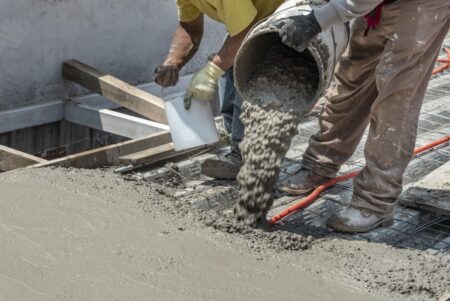Longtime northern New Jersey residents will likely never forget Superstorm Sandy’s brutal impact in the fall of 2012. Now, new projects in the Meadowlands and Hoboken areas aim to reduce the chances of any future storms causing so much flooding in the region.
North Jersey’s flood protection plans took a key step forward Sept. 20 when the state announced new contracts totaling nearly $298 million to support two major flood-resilience projects. One is set to be built in the Meadowlands, with another in nearby Hoboken and parts of Jersey City and Weehawken.
The Meadowlands communities that will benefit include Little Ferry, Carlstadt, Moonachie, South Hackensack and Teterboro, reported NorthJersey.com.
Both projects will be designed to protect the areas from flooding caused by severe storms and rising sea levels — issues tied to worsening climate change impacts.
The contracts were announced by Shawn LaTourette, commissioner of the New Jersey Department of Environmental Protection (NJDEP), as part of Climate Week, designed to educate the public about climate change and actions to address its effects.
Better Protection Needed From More Destructive Storms
The Meadowlands building project aims to lower the risk of high water from rainfall and to accelerate recovery times from storm surge flooding within the Losen Slote Creek watershed in Little Ferry and surrounding towns, according to NJDEP.
Rebuild by Design Meadowlands (RBD-Meadowlands) was created after Superstorm Sandy to reinforce flood resiliency in Little Ferry and nearby towns also hit hard by the 2012 storm.
The storm surge caused the Hackensack River to flood and “took over 70 percent of the town,” Little Ferry Mayor Mauro Raguseo told NorthJersey.com. Today, the low-lying and densely populated area remains vulnerable to flooding, especially given the growing impacts of climate change.
Union Paving & Construction in Mountainside, N.J., was awarded a $45.6 million contract to manage the project and is scheduled to begin construction sometime this fall. The company plans to install new infrastructure to improve drainage in the watershed as well as build a second pump station and make channel improvements.
According to a NJDEP fact sheet, due to old age, the area’s network of drainage channels and ditches does not allow for adequate drainage after heavy rains. Construction crews will deepen and widen the East Riser Ditch, remove sediment and debris, and add native plants to the embankment to enhance biodiversity.
Union also will replace the railroad bridge over the East Riser Ditch in Carlstadt, which is one portion of the project among others that may temporarily affect traffic in the area.
“When completed, this project will have a measurable impact in preventing flooding in a large area of our community that has been prone to rising water in heavy rainstorms,” Raguseo explained. “Like any major infrastructure construction project there may be detours and disturbances for a period of time, but it will certainly be worth it in the end when we see the final result.”
With enough funds, NJDEP said the Meadowlands project may also include a new park and green infrastructure designed for municipally owned buildings in the area.
Larger Award Goes to Hoboken Project
The Rebuild by Design Hudson River (RBD-Hudson) project in Hoboken, across the river from Manhattan, will include building more than 9,000 linear ft. of floodwall and the installation of floodgates and construction of berms and levees — comprehensively referred to as “resist structures” — to provide barriers during extreme high tide and storm surge events, NJDEP noted.
E.E. Cruz & Co., a Whitestone, N.Y., contractor, was awarded a $251 million contract to both build these structures and blend them into the fabric of the project area, including Harborside Park in Hoboken (to be renamed Cove Park), by incorporating seating, planters, lighting and educational and artistic murals.
The project also will include a comprehensive stormwater drainage component through the installation of curb and sidewalk drains and the removal of impervious pavement.
Preliminary work and preparatory activities by E.E. Cruz got under way in August, NorthJersey.com reported. More significant construction efforts, such as utility relocation and the start of construction on the floodwall elements, are anticipated to begin in early 2024.
The first phase of the RBD-Hudson project was a Sewer Separation Modification contract, completed in July 2022 for about $7 million, which infrastructure to separate portions of the combined sewer system in Hoboken to ensure that water from a storm surge event will not undermine the resilience structures after they are constructed.
NJDEP said the sewer separation effort will lead to better protection of public health by preventing the mixture of wastewater with stormwater during flooding events. The work included sealing more than 100 existing manholes, installing more than 30 additional manholes and 40 catch basins, adding 4,000 linear ft. of stormwater pipe, and installing eight stormwater treatment devices.
Strengthening the resilience of communities affected by Superstorm Sandy was the goal of the U.S. Department of Housing and Urban Development (HUD) through its Rebuild by Design competition grant program, which launched in the summer of 2013 as a result of the devastation that resulted in New Jersey and neighboring states.
Since the initial HUD award, both projects have received additional monies, including funds from the federal American Rescue Plan and FEMA’s Building Resilient Infrastructure and Communities fund.
Rebuild By Design Hudson River — Project Overview Map
Read the full article here











